Sea Bed Fishing (Demersal)
The Mauritanian sea bed fish stock is clearly over exploited as there are more than 180 Mauritanian fishing boats and an additional 150 European ones fishing in Mauritanian waters.
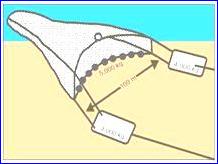
The main reason for this is that sea bed fishing is easy to perform: Pulling a trawl on the sea bottom is not very demanding and all fish caught can be sold for a good price, whether on the spot or in Europe . Deep-sea demersal trawling gear is large and heavy and has a very substantial impact on the seabed environment as a single deep-sea trawler may rake over 10 km˛ of seabed, daily. Deep-sea demersal trawling gear The general effects of trawling are well identified. They include extinction of species that form the habitat-structure, decrease in biodiversity and a large loss of long-lived organisms. The direct impacts of high seas demersal fishing vary depending on the nature of sea bed. Fauna on stable substrates (such as mud, gravel and coral) are more affected by bottom contact than those on less consolidated coarse sediment (i.e. sand). When the seabed is turned over, boulders are dislodged, large permanently attached animals are removed or damaged and clouds of mud are generated influencing areas far larger than the trawl path by itself. These impacts can reduce the available stock as well as the diversity of the benthos and totally change the species composition of benthic communities. These adverse effects can continue for long periods (>18 months) after the trawling has ceased and its visible impact is no longer evident.
The benthic zone is the lowest level of the ocean. It is inhabited by organisms that live in close relationship with (if not physically attached to) the ground, called benthos or benthic organisms.
The Mauritanian authorities are therefore strictly regulating demersal fishing licenses. Today there is a wide range of towed fishing gear for catching demersal fish, just off the bottom and in mid-water. They are suitable for all sizes of vessel working alone or in pairs. Various types of seines are used for surrounding large shoals of fish in open water or small shoals near the coast, static nets that catch fish by enmeshing them, traps for lobsters and crabs, pots for cephalopods (octopus), lines set to catch fish on baited hooks and so on…
Demersal fishing gears:
The following data are abstracts elaborated from information published by the Fisheries Research Services (FRS Marine Laboratory, Aberdeen, Scotland)
Trawling
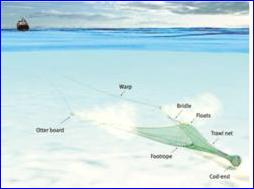
Trawling is the operation of towing a net to catch fish, and the basic requirements for operating the trawl-net are sufficient power to tow the net, a means of holding the mouth of the net open while towing, a system of wires to connect the net and gear to the source of towing power and the ability to cast and haul the net. Large deep-sea trawlers provide the necessary towing power with the size of gear scaled to match available horsepower. They may be designed to tow the fishing gear either from the side or from the stern and also provide accommodation for the crew, transportation to and from the fishing grounds and a working platform for fishing operations. Winches installed on deck move and store the trawling wires or warps. Auxiliary winches, power blocks and net drums or used to handle the gear while hauling and shooting.
Purse-Seining
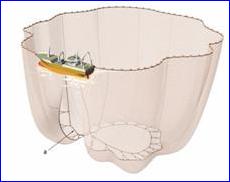
Purse seiners capture large aggregations of pelagic fish that shoal in mid-water or near the surface by surrounding these concentrations with a deep curtain of netting which is supported at the surface by floats. Small lead weights on the underside of the curtain ensure that the leadline quickly sinks and the net is then pursed under the shoal by heaving on a wire or purseline (a) which runs through steel rings attached to the lower edge of the net. When the gear is closed and fish can no longer escape, the netting is hauled lengthwise using a mechanised power block until the fish are packed tightly in the bunt, or last remaining section of the net to be hauled. The fish are then pumped or brailed aboard the vessel.
A large purse seine can be as long as 1 kilometer and 200 meters deep. Purse seiners generally try to avoid bottom contact as the small mesh nylon netting is easily damaged.
Potting and Creeling
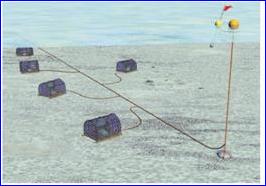
Creels and pots are small traps with fresh bait laid on the seabed to catch lobsters, langoustines (Nephrops norvegicus) and cephalopods. Generally, this class of vessel will haul approximately 500 to 700 creels in any one day, but may also have other creels fishing which may only be lifted three or four times per week, such as lobster or langoustine gear. A 10 m creel boat may work 700 langoustine creels but also have another 100 dedicated solely to lobster.
Creel vessels in this class tend to be somewhat small and generally don’t have vivier (Fish tank) capability. If there is a requirement for in-water storage, deck tanks may be fitted. However, these vessels tend to operate on a daily basis, returning to the home port each night and storing catches in large ‘keep’ boxes on a permanent mooring to await the weekly or bi-weekly market.
Long Lines
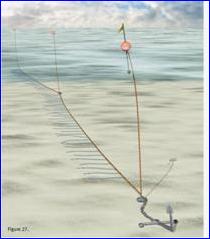
In long line fishing, a number of strings each consisting of a main line with baited hooks on branch lines (called snoods) are connected end to end and placed on or just off the seabed with an anchor and a marker buoy at each end. Intermediate buoys are used to mark changes in the direction of the long line.
A traditional great line may consist of up to 30 long lines. Each line is typically made up of six strings of 16 hooks fastened together end to end. One vessel may use three or four great lines, with a total length of up to 20 kilometers, bearing up to 12,000 hooks.
Automatic baiting machines ensure that each hook carries fresh bait every haul and the line magazines which store line and hooks in sequence greatly reduce the possibilities of foul gear. With mechanized systems up to 48,000 hooks may be worked per day. Lines are hauled using a constant tension combination hauler which untwists and racks the line after smaller fish are removed by the hook cleaner. Larger fish may have to be gaffed aboard. As hauling proceeds the line magazines are automatically filled in sequence ready for shooting.
Longliners may spend many days, even weeks, at sea on fishing banks hundreds of miles offshore with the catch preserved on ice or frozen. Enclosed deck shelters as well as the machinery described above have considerably improved working conditions for crews in what has always been an arduous and sometimes perilous fishery.
Set-Nets

Set-nets are long walls of netting which trap fish and shrimp either by gilling or entanglement, depending on the size of mesh and the tightness of the netting. The netting is hung on ropes and the hanging ratio can range from a loose 0.3 for tangling fish to a tight 0.6 for gilling. Nets for demersal fish are 1.5 m - 6 m deep and between 50 and 200 m long.
The netting is mostly woven from fine nylon twine, which is practically invisible underwater under most conditions. Twine thickness ranges from 0.2 to 0.9 mm. Several types of twine are available and the choice is a compromise between stiffness for ease of handling and softness for catching efficiency. Multi-monofilament twine is commonly used and this consists of 8 to 12 strands of thin monofilament, about 0.15 mm thick, lightly twisted together. Plastic floats, either ring, cylindrical or egg-shaped, are attached to the headline to keep the netting upright. The nets may be used singly or a number joined in fleets with suitable moorings to hold them in place.
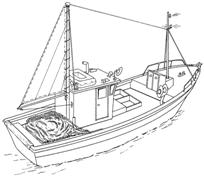
Larger vessels which fish offshore may have more elaborate machinery for hauling, clearing and stacking the nets and can work over 20 km of nets. The main advantage of set nets over towed nets for demersal species is that when tightly hung they are very size selective and retain few juveniles.
If shot and hauled quickly the fish quality can be good. Set netters operating gillnets, during fishing operations the vessel is not attached to the gear The size of the vessels varies from open boats up to large specialized drifters, operating on the high sea.
Gillnets can be operated from decked small vessels in coastal waters and medium sized vessels fishing offshore.
In coastal waters, it is very common that gillnetting is used as a second fishing method carried out by trawlers or beam trawlers, according to fishing season and targeted species. These trawlers use strong outrigger booms to tow their fishing gear. Double-rig beam trawlers tow two trawls, one from either side.

Typical deck equipment consists usually of two very heavy outriggers each towing one beam trawl by means or warps passing through blocks at the end of the outriggers.
Fish Detection Equipment consists of a sonar and an echo-sounder. Fresh catch is stored in boxes or in containers chilled with ice. Larger vessels might freeze the catch. Shrimps trawlers are fit with storage equipment for hauling and stowing the net aboard..


 - °
- °

